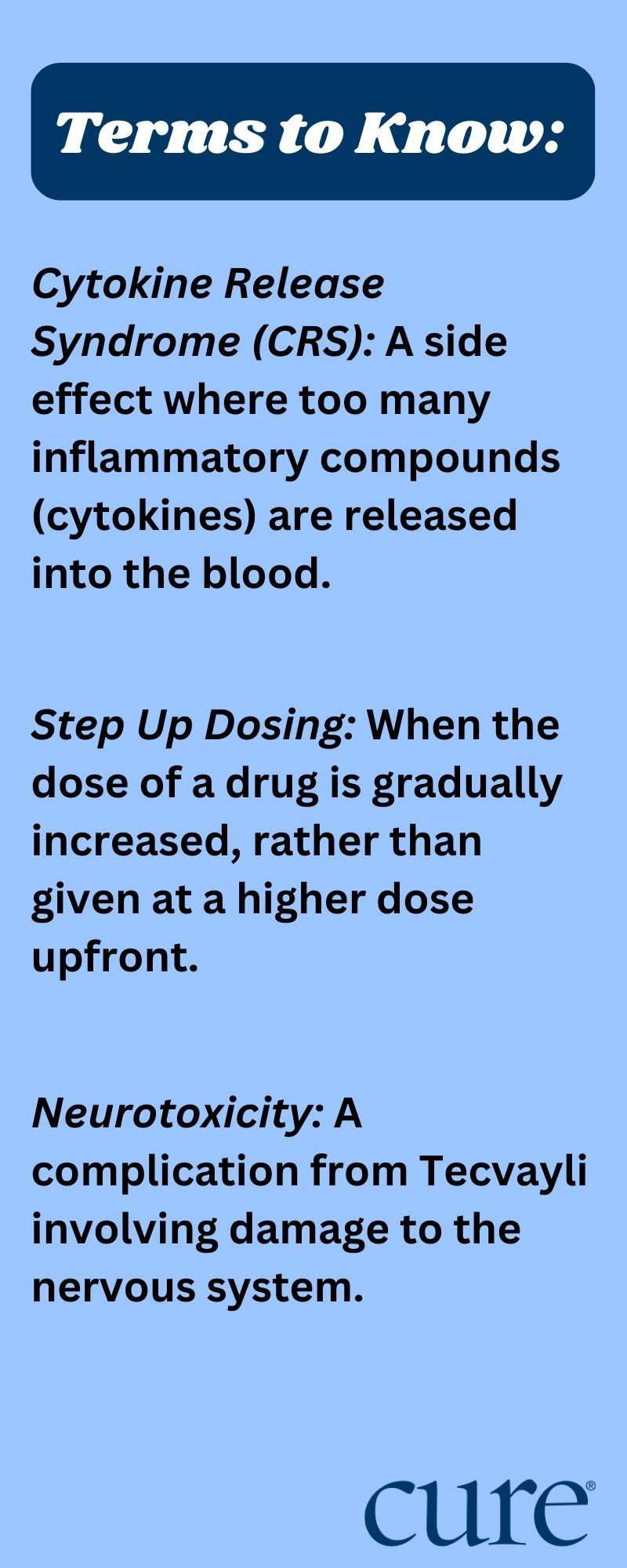Article
Patients With Myeloma Must Recognize the Signs of Cytokine Release Syndrome
Author(s):
Patients with myeloma who are being treated with Tecvayli must discuss symptoms of cytokine release syndrome with their providers as soon as they happen.
Knowing the signs of cytokine release syndrome (CRS) and promptly communicating them with their health care team is essential for patients with multiple myeloma to stay safe after receiving treatment with Tecvayli (teclistamab-cqyv), a drug that was approved in October 2022 for pretreated relapsed/refractory myeloma.
Safety data from the phase 1/2 MajesTEC-1 study which were presented by oncology nurse Donna Catamero during the 48th Annual Oncology Nursing Society (ONS) Congress demonstrated that CRS was successfully managed with premedication, step-up dosing and prompt diagnosis as well as intervention for patients treated with Tecvayli.

CRS is a systemic inflammatory response associated with T-cell engaging-bispecific antibodies, such as Tecvayli.
In MajesTEC-1, 72.1% of patients experienced CRS. All events were mild or moderate, save for one patient who experienced a grade 3 event in an infection setting. Grade 1 and 2 events were reported in 50.3% and 21.2% or patients, respectively. The median time to CRS onset was two days (range, one through six) with a CRS median duration of two days (range, one through nine). There were no recurrent cases reported.
Conditions such as infections can present with similar symptoms as CRS; therefore, early discussions between patients and providers can help determine the cause of the symptoms. Of note, it is advised that all infections be resolved before beginning treatment with Tecvayli, as infections may exacerbate CRS.
CRS management strategies were chosen in accordance with CRS severity and institutional guidelines. Supportive measures included Actemra (tocilizumab; 36.4%), intravenous fluids (13.9%), low-flow oxygen (12.7%), steroids (8.5%), single vasopressor (0.6%) and other (61.2%). Patients were able to receive more than one supportive measure. Actemra, which is an immunosuppressive drug, could be considered as an intervention for grade 1 CRS and was recommended for CRS occurring at grade 2 or higher.
According to study authors, almost all patients who experienced a CRS event did so during step-up dosing (meaning that the dosage of Tecvayli was gradually increased) and all first CRS events occurred before the end of cycle 1. These findings highlight the importance of frequent monitoring and extra vigilance during this time period, they said.
“In our experience the real-world supportive care measures for CRS align with those outlined in the MajesTEC-1 study protocol and with the (Tecvayli) prescribing information. We frequently gave (Actemra) with grade 1 CRS — especially in cases where there was no improvement with symptomatic treatment,” Catamero, associate director of myeloma research at Mount Sinai, wrote in the poster.
Vitals were monitored before each Tecvayli dose and four to six times a day. Every two to four hours, the inpatient nursing team assessed temperature, respiration, O2 saturation, neurologic assessment, blood pressure, heart rate and cardiac monitoring. Any other symptoms were discussed as needed (shivering, pain, rash, difficulty breathing, etc.).
The American Society for Transplantation and Cellular Therapy Criteria was used to grade CRS and the immune effector cell encephalopathy questionnaire was used in addition to handwriting assessments to monitor for possible neurotoxicity, a condition where the drug impacts the central nervous system.
A risk evaluation and mitigation strategy program was used to assist in training nurses to recognize CRS in addition to in-services, online modules, clinical lessons and posters/leaflets which are also tools utilized in the monitoring and managing CRS. Patients were also educated on CRS as a potential side effect.
For more news on cancer updates, research and education, don’t forget to subscribe to CURE®’s newsletters here.




